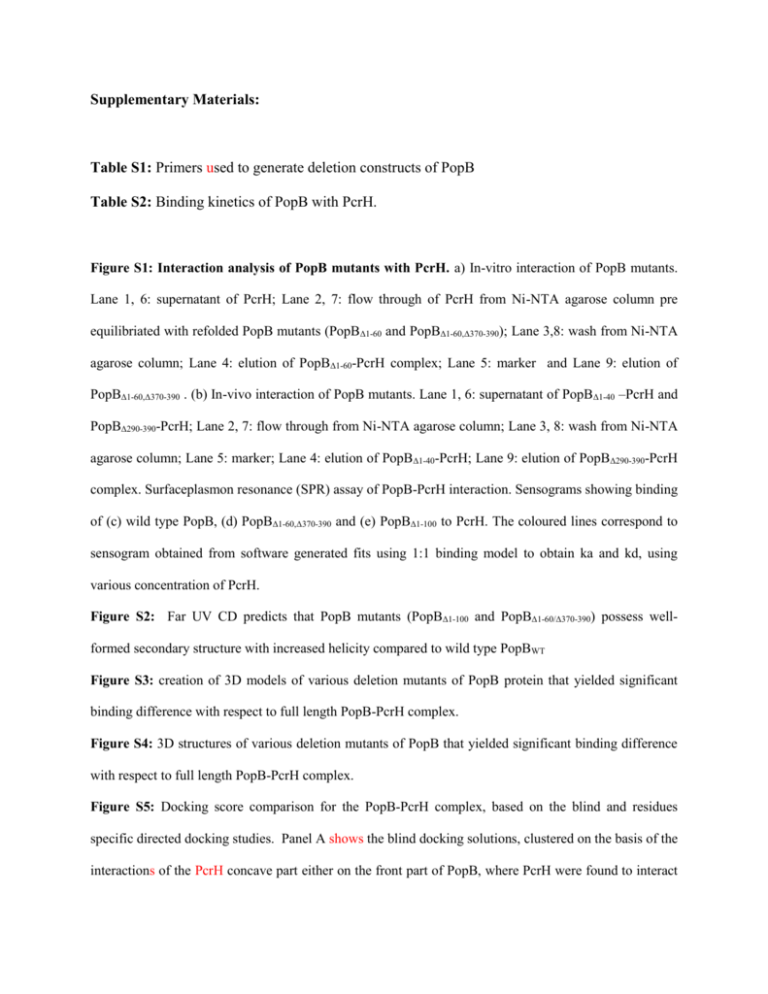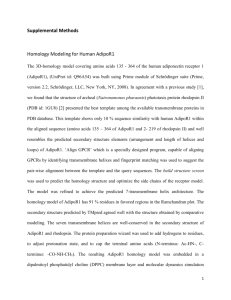prot24666-sup-0001-suppinfo
advertisement

Supplementary Materials: Table S1: Primers used to generate deletion constructs of PopB Table S2: Binding kinetics of PopB with PcrH. Figure S1: Interaction analysis of PopB mutants with PcrH. a) In-vitro interaction of PopB mutants. Lane 1, 6: supernatant of PcrH; Lane 2, 7: flow through of PcrH from Ni-NTA agarose column pre equilibriated with refolded PopB mutants (PopBΔ1-60 and PopBΔ1-60,Δ370-390); Lane 3,8: wash from Ni-NTA agarose column; Lane 4: elution of PopBΔ1-60-PcrH complex; Lane 5: marker and Lane 9: elution of PopBΔ1-60,Δ370-390 . (b) In-vivo interaction of PopB mutants. Lane 1, 6: supernatant of PopBΔ1-40 –PcrH and PopBΔ290-390-PcrH; Lane 2, 7: flow through from Ni-NTA agarose column; Lane 3, 8: wash from Ni-NTA agarose column; Lane 5: marker; Lane 4: elution of PopBΔ1-40-PcrH; Lane 9: elution of PopBΔ290-390-PcrH complex. Surfaceplasmon resonance (SPR) assay of PopB-PcrH interaction. Sensograms showing binding of (c) wild type PopB, (d) PopBΔ1-60,Δ370-390 and (e) PopBΔ1-100 to PcrH. The coloured lines correspond to sensogram obtained from software generated fits using 1:1 binding model to obtain ka and kd, using various concentration of PcrH. Figure S2: Far UV CD predicts that PopB mutants (PopBΔ1-100 and PopBΔ1-60/Δ370-390) possess wellformed secondary structure with increased helicity compared to wild type PopBWT Figure S3: creation of 3D models of various deletion mutants of PopB protein that yielded significant binding difference with respect to full length PopB-PcrH complex. Figure S4: 3D structures of various deletion mutants of PopB that yielded significant binding difference with respect to full length PopB-PcrH complex. Figure S5: Docking score comparison for the PopB-PcrH complex, based on the blind and residues specific directed docking studies. Panel A shows the blind docking solutions, clustered on the basis of the interactions of the PcrH concave part either on the front part of PopB, where PcrH were found to interact with α1, α2, α4 and α9 of PopB or the rear part of PopB, where PcrH were found to interact with 51-59 region of PopB within 5Å distance. The shape complementary score comparison shows the binding of PcrH onto the front part of PopB has greater binding preference with comparatively higher binding score over the binding of PcrH at the rear part of PopB model (51-59 region). Panel B. The directed docking analysis was performed considering two different docking scenarios, i) where all the interface residues of the front part of PopB and concave part of the PcrH were provided as the seed region and ii) where only the 51-59 region of PopB and concave part of the PcrH were provided as the seed region for the docking. The shape complementary docking scores for the respective scenarios clearly suggest that the binding of concave part of PcrH with the front part of PopB model has comparatively higher preference of binding than at the rear part of PopB model (51-59 region). Figure S6: Estimation of the binding affinity of the peptide resembling the 51-59 (TGVALTPPS) region of PopB with PcrH and some non-related protein structures. ∆G of binding (kcal/mol) of PcrH complexed with the peptide resembling the 51-59 of PopB was estimated. Region 51-59 of the PopB protein was further utilized to extract similar segments using both sequence and structure based searches against all other proteins. Top three most similar segments were further docked onto the PcrH structure and the corresponding binding affinities of the complexes were calculated. Panel A shows the crystal structure P. aeruginosa PcrH (PDB ID: 4JL024) complexed with peptide resembling the 51-59 region of PopB and their corresponding ∆G of binding in kcal/mol. Panel B shows the structural representation of PcrHpeptide complex where the peptide was removed from the complex crystal structure and further docked onto the PcrH crystal structure using the docking protocol used in this study. Panel C-E show docking modes and corresponding ∆Gs of interaction (kcal/mol) of completely unrelated protein segments that are sequentially (>=70%) and structurally (root mean square deviation [RMSD]: <=1Å) similar to the 51-59 (TGVALTPPS) region of PopB. The PopB segment was found to be most similar with a nucleoplasmin core protein (PDB ID: 1K5J; region: 93-99), a putative aminotransferase protein (PDB ID: 3EZ1; region: 368-373A) and a bacterial alanine racemase (PDB ID: 4A3Q; region: 101-107), respectively. These segments were further docked onto the PcrH structure (PDB ID: 4JL0) and the corresponding ∆Gs of interaction (kcal/mol) are shown in the respective panels. Docking protocol The chain A subunit of the crystallographic structure of a regulatory protein, PcrH from P. aeruginosa (PDB ID: 2XCC) was docked to the best fit model of PopB using the protein-protein docking mode of PatchDock docking program1. Further, based on the mutation analysis, we have generated structures of the corresponding mutants of the PopB and they are also allowed to dock with PcrH, in order to identify the probable docking mode of each mutant. In this study we carried out the following two different modes of docking analysis: 1. Blind docking studies. 2. Directed docking studies. In the blind docking analysis, the crystallographic structure of a regulatory protein, PcrH (PDB ID: 2XCC) was allowed to dock with the best wild type and mutant models of PopB structures. The best docking solutions from the most populated clusters interacting with the ‘head’ part (α1, α2, α4, α9) of PopB were selected and subjected to FireDock2 and PDBePISA3 server for the calculation of global energies and free energies (G) of binding respectively. In case of directed docking studies the binding residues were provided for both the PopB and PcrH structures. In case of mutant PopB-PcrH directed docking, the deleted residues of mutant PopB structures were excluded from the list of binding residues list. In each directed docking experiment, a constant number of 34 AA from α1, α2, α3, α4, α5, α6, α7 were provided as the seed region for PcrH, whereas 36 AA from α1, α2, α4, α9 were provided as the seed residues for model PopB (wild type). The number of seed residues varied for each mutant of PopB. Following is a list of mutant PopB models and their respective seed residues. PopB Mutant Region Deleted Total Number of Seed Residues Δα1 2-48 AA 34 Δα2 65-91 AA 22 Δα4 111-128 AA 31 Δα9 370-390 AA 24 Δα1+Δα9 2-48 & 370-390 AA 23 Δα1+Δα2+Δα9 2-48 , 65-91& 370-390 AA 9 Δ1_60+Δα9 1-60 & 370-390 AA 22 Δ1_80 1-80 AA 23 Δ100-390 1-100 AA 20 Top 100 docking solutions were screened for both docking experiments and the best docked complex was identified based on critical manual inspection satisfying favorable interactions between two proteins. Selected docked solutions were further refined and re-scored using the FireDock refinement server2. Approximate G of binding of the selected docked complexes was calculated using the PDBePISA server3. Calculation of global energies by FireDock2 The global energy can be termed as the binding energy of the docking complex which changes upon complex formation. ∆𝐺 = 𝐺 𝐶 − (𝐺 𝑅 + 𝐺 𝐿 ) Where, 𝐺 𝐶 = 𝐹𝑟𝑒𝑒 𝑒𝑛𝑒𝑟𝑔𝑦 𝑜𝑓 𝑡ℎ𝑒 𝑟𝑒𝑐𝑒𝑝𝑡𝑜𝑟 𝑙𝑖𝑔𝑎𝑛𝑑 𝑐𝑜𝑚𝑝𝑙𝑒𝑥 𝐺 𝑅 = 𝐹𝑟𝑒𝑒 𝑒𝑛𝑒𝑟𝑔𝑦 𝑜𝑓 𝑡ℎ𝑒 𝑢𝑛𝑐𝑜𝑚𝑝𝑙𝑒𝑥𝑒𝑑 𝑟𝑒𝑐𝑒𝑝𝑡𝑜𝑟 𝐺 𝐿 = 𝐹𝑟𝑒𝑒 𝑒𝑛𝑒𝑟𝑔𝑦 𝑜𝑓 𝑡ℎ𝑒 𝑢𝑛𝑐𝑜𝑚𝑝𝑙𝑒𝑥𝑒𝑑 𝑙𝑖𝑔𝑎𝑛𝑑 Upon complex formation the interacting residues within 6Å are considered as the interface (intef) residues and remaining residues are considered as non-interface (nintrf) residues and 𝑅 𝐿 𝐺 𝐶 𝑛𝑖𝑛𝑡𝑟𝑓 = 𝐺𝑛𝑖𝑛𝑡𝑟𝑓 + 𝐺𝑛𝑖𝑛𝑡𝑟𝑓 Further the complex energy is splitted into intra molecular (intra) and inter molecular(inter) energy. The final ∆G can be described as 𝐶 𝐶 𝑅 𝐿 𝐿 𝑅 ∆𝐺 = 𝐺 𝐶 𝑖𝑛𝑡𝑒𝑟𝑓 = 𝐺𝑖𝑛𝑡𝑟𝑓 − (𝐺𝑖𝑛𝑡𝑟𝑓 + 𝐺𝑖𝑛𝑡𝑟𝑓 ) = 𝐺𝑖𝑛𝑡𝑟𝑓_𝑖𝑛𝑡𝑒𝑟 + ∆𝐺𝑖𝑛𝑡𝑟𝑓_𝑖𝑛𝑡𝑟𝑎 + ∆𝐺𝑖𝑛𝑡𝑟𝑓_𝑖𝑛𝑡𝑟𝑎 Calculation of binding energy by PDBePISA3 (∆𝑮) The binding free energy of a complex (∆𝐺𝑖𝑛𝑡 ) is estimated as follows: ∆𝐺𝑖𝑛𝑡 = ∆𝐺𝑠𝑜𝑙𝑣 + 𝑁ℎ𝑏 𝐸ℎ𝑏 + 𝑁𝑠𝑏 𝐸𝑠𝑏 + 𝑁𝑑𝑏 𝐸𝑑𝑏 Where, ∆𝐺𝑠𝑜𝑙𝑣 is the solvation energy gain upon complex formation. 𝑁ℎ𝑏 ,𝑁𝑠𝑏, 𝑁𝑑𝑏 are numbers of formed hydrogen bonds, salt bridges and disulphide bonds, respectively. 𝐸ℎ𝑏 ,𝐸𝑠𝑏, 𝐸𝑑𝑏 stands for their free energy effects. Table S1 Name of Construct PopBΔ1-20 (S) PopBΔ1-45 (S) PopBΔ1-60 (S) PopBΔ1-80 (S) PopBΔ1-100 (S) PopBΔ370-390 (As) PopBΔ350-390 (As) PopBΔ330-390 (As) PopBΔ310-390 (As) PopBΔ290-390 (As) PopBWT (S) PopBWT (As) PopBΔ1-60/ 370-390 PopBΔ1-60/ 350-390 Deletion First 20 amino acid from N-terminal First 45 amino acid from N-terminal First 60 amino acid from N-terminal First 80 amino acid from N-terminal First 100 amino acid from N-terminal Last 20 amino acids from C-Terminal Last 40 amino acids from C-Terminal Last 60 amino acids from C-Terminal Last 80 amino acids from C-Terminal Last 100 amino acids from C-Terminal First 60 amino acid from N-terminal & Last 20 amino acids from C-Terminal First 60 amino acid from N-terminal & Last 40 amino acids from C-Terminal Primer sequence 5’----------------------3’ TTAGAATTCGCATATGATCCCGGCGCTCGG TTAGAATTCGCATATGGCTTCCGCGAGCGG TTAGAATTCGCATATGGCCAGCCAGCAGCG TTAGAATTCGCATATGGTGGGCGAGGATGT TTAGAATTCGCATATGTCCGCCGGCCTGAT TTAAGTCGACTCAGAAGATCCGCTCCATGA TTAAGTCGACTCAGCGCTCGATCACGCCCT TTAAGTCGACTCAGCGGTTCGCGGCCTT TTAAGTCGACTCAGTCCAGGGTCAGGTC TTAAGTCGACTCAGGCCAAACTGCCGAA TTAGAATTCGCATATGAATCCGATAACGCTTGA TTAAGTCGACTCAGATCGCTGCCGGTCGGC Primer sequence of PopBΔ1-60 (S) & PopBΔ370-390 (As) Primer sequence of PopBΔ1-60 (S) & PopBΔ350-390 (As) Note: S:- Sense Primer, As:- Antisense Primer. The N-Terminal deletion constructs of PopB were generated using sense primer [PopBΔ1-20 (S), PopB Δ1-45 (S), PopB Δ1-60 (S), PopB Δ1-80 (S) and PopB Δ1-100 (S)] of the respective deletions and PopBWT (As). The C-Terminal deletion constructs of PopB were generated using antisense primer [PopB Δ370-390 (As), PopB Δ350-390 (As), PopB Δ330-390 (As), PopB Δ310-390 (As), PopB Δ290-390 (As)] of the respective deletions and PopBWT (S). Table S2 PopB mutants Figure S1 Interaction with PcrH PopBWT In vitro and in vivo studies yes SPR studies KD (10-6 )M 0.372±0.02 PopBΔ1-20 yes 0.402±0.06 PopBΔ1-40 yes 0.485±0.03 PopBΔ1-60 yes 0.592±0.07 PopBΔ1-80 yes 6.52±0.14 PopBΔ1-100 no 782.56±23.02 PopBΔ390-370 yes 0.469±0.03 PopBΔ390-350 yes 0.487±0.05 PopBΔ390-330 yes 0.525±0.03 PopBΔ390-310 yes 0.575±0.06 PopBΔ390-290 yes 0.577±0.04 PopBΔ1-60/ Δ390-370 no 28.52±0.34 PopBΔ1-60,/Δ390-350 no 30.83±0.46 Figure S2 Figure S3 Figure S4 Figure S5 Figure S6 References 1. Schneidman-Duhovny D, Inbar Y, Nussinov R, Wolfson HJ. PatchDock and SymmDock: servers for rigid and symmetric docking. Nucleic Acids Res 2005;33(Web Server issue):W363-367. 2. Mashiach E, Schneidman-Duhovny D, Andrusier N, Nussinov R, Wolfson HJ. FireDock: a web server for fast interaction refinement in molecular docking. Nucleic Acids Res 2008;36(Web Server issue):W229-232. 3. Krissinel E, Henrick K. Inference of macromolecular assemblies from crystalline state. J MolBiol 2007;372(3):774-797.



